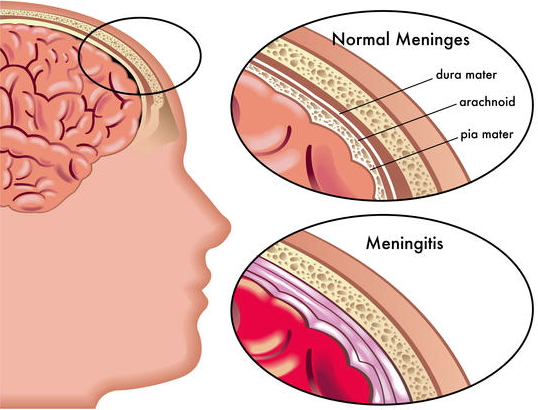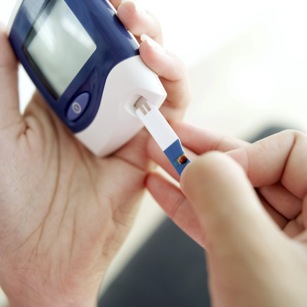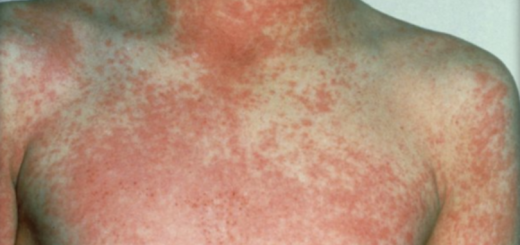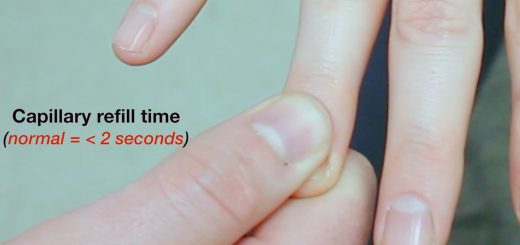Meningitis in Children and Babies
Meningitis refers to the infection of the meninges, the layered membranes that support and protect the brain and spinal cord. It most commonly strikes infants and children between the ages of one month and five years, although it can affect people of any age. Children under age two are particularly susceptible, and boys are affected more often than girls. Meningitis is always a serious condition that warrants emergency medical care.
In this first aid blog post, we’ll take a more in-depth look at the causes and treatment of Meningitis.
Causes of Meningitis
A variety of microbes can cause meningitis. The most serious forms are caused by bacteria that spread through the blood to the meninges from infections elsewhere in the body, such as the lungs, the sinuses or the throat.
Newborns sometimes develop meningitis as a result of infections their mothers contracted during the last week of pregnancy. Rupture of the fetal membranes more than 24 hours before birth also increases the risk of meningitis in a newborn, as does premature birth. Other factors associated with meningitis in children of all ages include severe burns, head injuries and chronic illnesses, such as sickle-cell anemia.
Viruses such as the Coxsackie virus and those responsible for chicken pox and mononucleosis also can cause meningitis. This type, known as aseptic meningitis, is generally less serious than the bacterial type.
Signs and Symptoms of Meningitis
Meningitis causes nonspecific symptoms in infants and toddlers. Often, parents will simply have a strong sense that all is not well, even though dramatic symptoms, such as a high fever, may not be present. Instead, the infant may be unwilling to nurse or take a bottle. Sucking may be feeble, and diarrhea and vomiting may occur. The baby may be listless, irritable, and the temperature may be elevated or abnormally low. Drowsiness, irregular breathing and seizures also may occur. Another possible sign is bulging of the soft spot in the top center of the baby’s head.
Symptoms in older children include irritability, agitation and loss of appetite, followed by the abrupt onset of fever, chills, headache, nausea and vomiting, sometimes along with confusion. This pattern, however, is by no means universal. Some children develop signs and symptoms more slowly, so the disease looks at first like a case of the flu. Children old enough to verbalize their symptoms may complain of back pain, neck stiffness and sensitivity to light.
Treatment Options for Meningitis
An infant or child with bacterial meningitis will be hospitalized and given intravenous antibiotics, along with medication to control fever and fluids to prevent dehydration. A child with bacterial meningitis is isolated from other patients. Nurses, doctors and parents may have to wear protective gowns and gloves in the child’s room. The child’s close contacts will need to take antibiotics as a precaution against developing the disease or reinfecting the child.
In cases of aseptic meningitis, hospitalization and isolation may be necessary until bacterial meningitis is ruled out. Otherwise, treatment is focused on relieving discomfort and waiting for the infection to subside, which usually takes three to ten days.
Complications of Meningitis
Infants and children with bacterial meningitis may develop hydrocephalus, brain abscess and impaired hearing, vision and poor muscle control. In addition, bacterial meningitis sometimes leaves a child with a long-term seizure disorder. Some evidence suggests that children who have had meningitis run an increased risk of developing behavior problems, learning disabilities and attention-deficit disorder. In general, though, the outlook for children with meningitis has improved greatly in recent years, thanks to better antibiotics and more rapid diagnosis.
Prevention of Meningitis
Until the mid-1980s, Hemophilus influenza type B was the bacterium responsible for most cases of meningitis in children, especially in the under-two age group. Widespread immunization against this organism has caused a sharp decline in the number of cases of meningitis. The American Academy of Pediatrics strongly urges that all children be immunized against this organism.
Vaccines against other organisms associated with meningitis also are available, although they are recommended mainly for children at high risk of infection due to chronic illness or suppressed immunity.
Types of Meningitis
Listed below are the various types of meningitis to know about:
Bacterial Meningitis
Bacterial meningitis often spreads from one person to another. The bacteria are usually present on or within the bodies of human beings, be it children or adults. However, this does not automatically entail that they will get sick. Instead, they can spread the bacteria to those around them.
Bacterial meningitis can be quite dangerous and can often be caused due to a sinus or ear infection, a skull fracture, and on rare occasions, due to certain surgeries.
Viral Meningitis
Viral meningitis is mostly mild and usually gets cured on its own. It can, however, be serious among infants who are younger than three months, and also among other high-risk children.
There are some viruses that can lead to a serious case of viral meningitis in both adults and older children, such as herpes simplex.
Amebic Meningitis
An amoeba named Naegleria fowleri is responsible for causing amebic meningitis. People are infected with this type of meningitis when the amoeba makes its way up the nose to the person’s brain.
Amebic meningitis doesn’t spread from one person to another. The amoeba can be found in warm freshwater lakes and rivers where people go swimming. They can also be found in pools, tap water, splash pads, and in soil.
One can’t get infected by amebic meningitis by drinking water that has been contaminated by this amoeba.
Fungal Meningitis
Fungal meningitis can occur due to the various kinds of fungi present in the environment. It can also be caused due to medical procedures if proper infection control practices aren’t implemented.
Parasitic Meningitis
Parasitic meningitis is not as common as bacterial and viral meningitis. The parasites that cause this type of meningitis can usually be found in animals.
Humans get infected with parasitic meningitis when they consume contaminated foods or if they accidentally consume soil that has been contaminated by the feces of animals that are infected.
How is Meningitis Diagnosed?
When you go to your doctor, they will firstly conduct a physical examination. They will also ask you about your symptoms and test your cerebrospinal fluid (CSF). You could also be asked if you have traveled recently or been around people with certain illnesses.
Your doctor might conduct certain tests to help in the diagnosis of meningitis:
- Throat or nasal swab: A soft-tipped stick is used to take a sample from your throat or nose to see if you have the symptoms of an infection.
- Blood tests: A sample of your blood is collected by inserting a needle into your arm, and the test is used to see if you’re displaying any signs of infection.
- MRI or CT scan: An MRI or CT scan helps in taking pictures of your brain to check if there is any inflammation.
- Lumbar puncture (spinal tap): During a lumbar puncture, a sample of your cerebrospinal fluid is taken by inserting a needle into your lower back, and the sample is then tested for signs of infection.
- Stool sample: A stool sample can help in determining if you have any signs of infection.
How to Check for Meningitis at Home?
While the Kernig and Brudzinski tests can be conducted at home to check if you have meningitis, it’s still wiser to visit a doctor to get your diagnosis done. Although these tests technically need to be performed by a medical professional, you can still get them done at home.
The thing to keep in mind is that meningitis can be quite life-threatening and although it can be diagnosed at home, it’s not possible to determine which type of meningitis you have. This is important to note since certain types of meningitis are quite dangerous.
One should get immediate medical attention if they display the following symptoms:
- Stiff neck
- Nausea or vomiting
- Feeling disoriented
- Painful and constant headache
- High fever
Here is how you can do the Kernig test at home:
- Start by lying flat on your back.
- By lifting your leg up at the hip, bend your knee to an angle of 90 degrees.
- Lift your leg up to your knee slowly and gently.
- If your thigh or back begins to hurt, then it’s a Kernig sign, which means that you probably have meningitis.
Here is how you can do the Brudzinski test at home:
- Lie down on your back.
- Push on the back of your neck slowly and gently in order to move your head forward. You can try to get someone to do this for you so that the results are better.
- Check if your knees and hips flex automatically when you raise your head. If they do, then you might have meningitis, as it’s a Brudzinski sign.
When Should I Call My Child’s Healthcare Provider?
Call your child’s healthcare provider under the following circumstances:
- If they’re vomiting.
- If they experience hearing loss.
- If they experience chills or have a fever where their body temperature is 38.3 degrees Celsius or above.
- If they display changes in behavior, such as if they are confused, sleepier or more irritable than usual, and if they are crying more than they usually do.
- If they have a stiff neck.
- If your baby has a bulging soft spot on their head.
- If they are experiencing severe headaches.
FAQs
What are the symptoms of meningitis in newborns?
Some of the symptoms of meningitis in newborns are high fever, vomiting, being inactive, facing trouble waking up from sleep, being very irritable or sleepy, crying constantly, and stiffness in the neck and body.
Can adults get meningitis?
Yes, meningitis can affect anyone at any age.
How common is meningitis?
Meningitis is quite common. About 3,000 people in the United States are diagnosed with bacterial meningitis every year.
Is there a vaccine for meningitis?
Yes, there is more than one vaccine for meningitis.
Can you live a normal life after meningitis?
Yes, most people recover completely after meningitis, although some of them can suffer certain long-term issues that could be life-threatening.
Can meningitis come back?
Recurrent bacterial meningitis is quite a rare possibility.
Conclusion
Although meningitis is quite a serious illness and calls for immediate medical attention, it is possible for people to survive most forms of meningitis. Bacterial meningitis, which is the deadliest of the common forms of meningitis, has a survival rate of about 90%.
Meningitis can become life-threatening if it’s not treated right away, and when treated properly, there is a chance for the person to recover completely. Therefore, if you display any symptoms related to meningitis, make sure to seek your healthcare provider right away.






